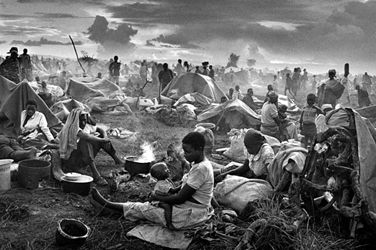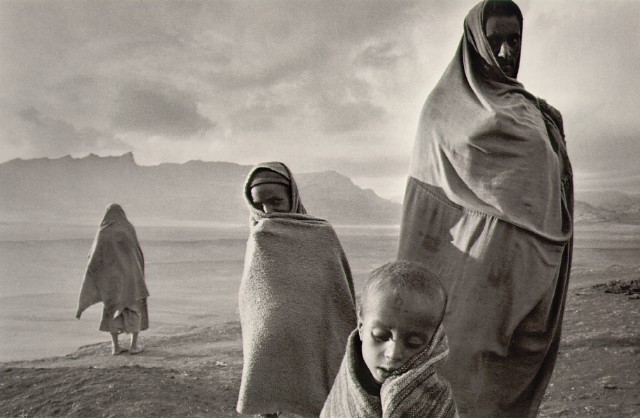Rwandan Refugees – Sebastao Salgado
When I was a kid, my parents had a book, The Family of Man by Edward Steichen.
It was a photo book to accompany an exhibit of photojournalism as art that Steichen had promoted and that had opened at the Museum of Modern Art in 1955.
At that time, it was rather radical to think of photography, let alone photojournalism as an art form.
But that book and that exhibit changed the world.
Above is a photo by Sebastao Salgado, my favorite photographer today. I own a few of his prints and they hang in my living room (or will as soon as the work is done), as a testament to the power of photography to capture and convey ideas and impressions as an art form.
What unleashed photojournalism as the combination of a new technology (small cameras like Leicas, roll film, faster speeds and so on) and talented people taking up that technology and creating great work.
Salgado in Sudan
Salgado is a member of Magnum, a cooperative of some of the best photographers in the world.
A few weeks ago, Mike Yamashita, a photojournalist for National Geographic was at my house with his wife Lil.
Mike had just come from a conference of Asian Journalists, and he said the hottest topic in the room was the discussion of video, as still photogs make the conversion to video. The talent is there, he said, and so is the technology. What is missing, of course, is how exactly to make a living doing this.
People will percolate into new field. My friend PF Bently, former White House photographer for Time Magazine has found a very lucrative niche in corporate videos and documentaries. Dirck Halstead, his companion at the White House from Time has founded Thedigitaljournalist.org
They were there early.
As more and more photographers and others enter the video field, it will no doubt shake itself out to be commensurate with the market’s demands.
All of this brings me to CTZN.TV, our embryonic website.
It has gotten the attention of the investors.
Their interest, and mine, is in the chance to create a ‘Magnum’ for video. A cooperate where the best videographers in the world could both show their work and share in the profits.
The investors are ready to commit.
The site is up.
What I need now are videos to demonstrate the potential that is out there, and people who would want to participate.
I don’t need a finished business – just the scent of what is possible.
Photographers and videographers would retain all credit and all rights to the videos posted.
At this moment, I am only trying to prove a point.


4 Comments
Jonathan Riezman October 27, 2008
If you are worried about protecting your imagined “rights” to your videos you are in the wrong universe. You can’t own an idea and once that video is out there it’s out there for everyone. Do you actually care about art? Go away and curl up in your storebought house.
Cliff Etzel September 16, 2007
$ – I think you raise an interesting perspective regarding the tables being turned on those still photogs who aren’t willing to make the jump to video given their credentials as still shooters.
I make no qualms at my level of experience as a video shooter – but everyday I make the effort to learn more about the craft. I know what it means to work day in and day out as a still shooter – I did it full time for many years. What I find now is that video gives me the creative rush I use to get when I shot stills – yet it has its own learning curve and many experienced still shooters I think are unwilling to go outside their comfort zone. I myself have found it discouraging at times but it’s a part of the learning process and once the “ah-ha” light comes on, it stays with me much in the same way it did when I grasped the things I needed to learn as a photojournalist in newspaper and magazine.
$ September 15, 2007
I find myself, once again, in agreement with Cliff. Especially when it comes to capturing reality.
However, what some may think of as “needing a load of gear” can, in fact, be true necessities to cover a variety of real issues even if that gear is never used.
A variety of mics, adapters, lights, even rain gear and other protection for the equipment and camera person quickly add up.
No one wants to bring a movie-set level of equipment with them and, yes, some go overboard and end up losing that element of closeness and “reality” many of us strive to achieve while maintaining a consistent level of professional quality.
It’s been pointed out before many young people with little experience think all one has to do is buy a camera and a lap top and they are ready to go. Then they lose audio or can’t get a key shot because they don’t have the other necessary equipment to achieve their goal of “quality” and “just as good” product.
I have long wondered why Magnum and other still photographer representatives have declined to get into the world of video. Many of the insults about GOB’s being afraid of change could be tossed their way as well. Or course, in their defense, it is much harder to police the use of video in today’s world. Getting that creator of the video’s fair share of profit from the sale and use of their hard work.
I think CTZN is on the learning curve of what will be required to protect and preserve rights of moving images. The sad truth is many times to protect those rights, one needs a lot of money up front to deal with the legal issues and fees involved in protecting the product from poachers and thieves who think everything should be free.
Cliff Etzel September 13, 2007
Salgado’s work is the epitome of minimalism – shooting with a couple of Leica Rangefinders and 2-3 lenses with bricks of b/w film. His tools didn’t get in the way, they were used to capture the essence of what he saw. Along with William Albert Allard’s work and David Alan Harvey, they were some of the photo-j’s I looked to when I hit a creative slump when I was working in newspaper and magazine.
The idea of minimalist (but as high quality as possible) gear can and should be translated over to video and the Solo VJ paradigm instead of the notion of needing a load of gear to accomplish ones work.